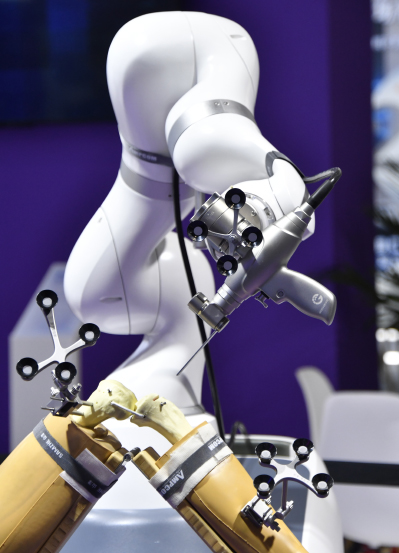| Business |
| Tech expo showcases AI innovations that improve people's lives | |
|
|
 A smart robot for orthopedic surgery displayed at the 27th China Beijing International Hi-tech Expo in Beijing on May 8. The four-day event wrapped up on May 11 Plush toys equipped with AI technology developed by Beijing-based AI company EFFYIC showcased at the 27th China Beijing International Hi-tech Expo (XINHUA)
Kunlun Tech, a Beijing-based Internet company, displayed its AI-powered music generator Mureka at the 27th China Beijing International Hi-tech Expo running from May 8 to 11, attracting crowds of visitors. After entering a prompt describing the desired genre and selecting a preferred model, users are able to create music. Starting from 2020, Kunlun Tech, founded in 2008, has been focusing on AI-related research and development (R&D). According to the company, the Mureka portal has been visited by users from over 100 countries and regions, and the AI model can respond to prompts in 10 languages. The expo this year showcased more than 1,000 scientific and technological innovations like Mureka. Themed Science and Technology for a Better Future, it gathered over 800 technology companies and institutions from around the world. AI took center stage at the event, showcasing transformative applications across the healthcare, education and manufacturing sectors. As of late 2024, China had more than 4,500 AI enterprises. More than 200 generative AI large models had been launched in the country, serving more than 600 million users, the Ministry of Industry and Information Technology said. According to a report released by the China Center for Information Industry Development (CCID) earlier this year, the market size of China's AI industry exceeded 700 billion yuan ($96 billion) in 2024, maintaining a growth rate of more than 20 percent over the past four years. For a better life The 2025 China Sleep Health Survey Report, released by the China Sleep Big Data Center in March, reveals that Chinese adults aged 18 and above average 7.06 to 7.18 hours of sleep per night, with 48.5 percent experiencing sleep disturbances. At the expo, Beijing-based AI company Diyixi Technology Co. Ltd. unveiled a smart pillow, showcasing innovative technological solutions for sleep-related issues. Cao Naicheng, the company's CEO, told Beijing Review that regular pillows fail to adapt to the physiological curvature of the cervical spine when people change sleep postures, which in turn affects sleep quality. "Our smart pillow is particularly beneficial for people with cervical spine issues," Cao said. He explained that the revolutionary product features an embedded microphone array and snore-recognition technology, enabling it to detect abnormal breathing patterns during sleep. It can then automatically adjust head support angles or deliver subtle vibrations to prompt users to change positions, thereby reducing snoring. Additionally, its built-in sensors collect data such as sleep latency, breathing patterns and heart rate and can detect potential signs of a heart attack. "For those struggling with insomnia, the pillow aligns with the user's preferred sleep position, and plays calming sounds to help them fall asleep faster," Cao said. Using a discreet collar-mounted device and a thin throat sensor, an AI-powered artificial throat can accurately detect voice vibrations imperceptible to the human ear and convert them into natural, fluent speech within just two seconds. The technology was developed by Beijing Xinzhiruisheng Technology Co. Ltd. "This innovation targets speech-impaired individuals, including laryngectomy patients, stroke survivors and people suffering from Parkinson's disease. It is designed to help them communicate with others effortlessly," company CEO Wang Yufeng told Beijing Review. Unlike many products on the market, Wang explained this wearable device requires no surgical implantation—eliminating patient discomfort. Using graphene sensors, it detects laryngeal muscle movements, then leverages AI to decode intended speech. Voice cloning and restoration technologies synthesize strikingly natural vocal output. The company has partnered with medical institutions and nonprofits, training the system on hundreds of hours of real-world data. A commercial release is slated for late 2026.  Plush toys equipped with AI technology developed by the Beijing-based AI company EFFYIC showcased at the 27th China Beijing International Hi-tech Expo (COURTESY PHOTO)
Upgrading traditional industries The ROPA AI system developed by Longwood Valley Medtech caught much attention at the expo. The company has developed the world's first AI-powered orthopedic surgical robot, utilizing deep learning and 3D modeling to enhance surgical precision. According to the company, surgeons typically rely on experience alone to determine prosthesis placement during preoperative planning, introducing uncertainty into the process. The ROPA system addresses the issues through a system that includes surgical simulation software capable of generating personalized 3D surgical plans within five to 10 minutes using a patient's CT scan. It is also equipped with an optical positioning system that monitors and tracks patient movements. Beijing Chaoyang Environment Group Co. Ltd. debuted an AI-powered incineration system, China's first intelligent waste-to-energy conversion system. In the second half of 2024, the system began trial operations in the company. So far, all three production lines have been fully operational. The AI technology has helped achieve an automatic operation rate of over 98 percent, decreasing manual workload by 80 percent and increasing electricity output by 4.2 percent, the company said. AI is also empowering the education industry. Jingle Magic, a tech company founded in Beijing in 2016, introduced its next-generation education devices, an AI-powered smart desk, at the expo. Han Haibo, Vice President of the company, told Beijing Review that classroom teaching in China still largely depends on the use of textbooks and slides, leaving students with little hands-on experience or visual engagement. The AI smart desk makes a difference. In biology class, placing a bird skeleton card on the desk will instantly generate a 3D model of the avian skeletal structure. Tapping the wing section reveals its biomechanical framework. In science class, after piecing together rocket component cards, students will see a launch simulation. According to Han, the desk has applied cameras with high-definition and sensors to simulate real-life scenarios. Six users can operate it simultaneously. "The system also allows students to provide immediate feedback to teachers and mitigate safety risks associated with hazardous experiments," he said. Beijing-based AI company EFFYIC also caters to children, particularly those left home alone. It integrates its AI model iBaoBao with plush toys, which can interact with humans, clone voices and translate between Standard Chinese and English. Using voice recognition AI, the toys detect emotional cues and deliver personalized comfort responses. Market potential China's AI market size will reach 1.73 trillion yuan ($240 billion) by 2035, accounting for 30.6 percent of the global total, according to market research company CCID Consulting. Zhao Xin, President of the School of AI at Nankai University in Tianjin, wrote in an article recently published by People's Daily newspaper that China still faces gaps in core AI theories and technologies. Its research in AI fundamentals such as neural network training processors still requires improvement to catch up in areas including core algorithms, chips and software systems. But China's manufacturing sector provides a solid foundation for AI-driven industrial upgrades. The growing 5G and Internet of Things networks offer great opportunities for AI applications, according to Zhao. Chinese AI companies should improve investment in talent cultivation and training and further integrate AI with traditional industries, he suggested. BR (Print Edition Title: Disruptive by Design) Copyedited by Elsbeth van Paridon Comments to lixiaoyang@cicgamericas.com |
|
||||||||||||||||||||||||||||||
|